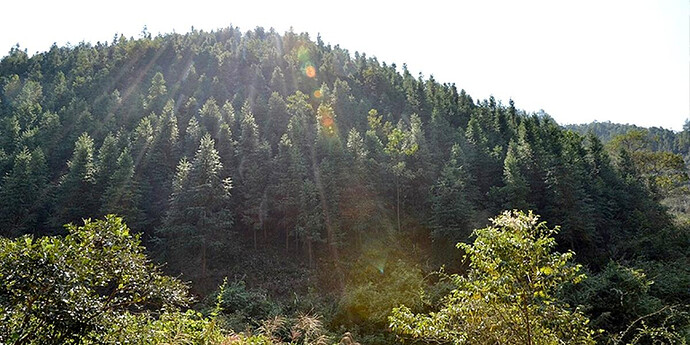If we want to transition to a bioeconomy, we will need more biomaterials. Finding them won’t be easy.
Speaking at a recent forestry conference in BC, futurist Nikolas Badminton enthused about recent forestry innovations, such as mass timber high-rises, wood-based windows, and electricity-generating floors. Indeed, one has only to open their daily newspaper to be inspired about the promise of a “bioeconomy” replacing carbon-intensive materials such as cement or plastic with bio-based ones such as wood fibre.
Unfortunately, while wood is increasingly viewed as a climate-friendly building solution, the logging activities that provide this wood are not viewed in the same positive light. Indeed, many people believe industrial forestry to be environmentally damaging in terms of both carbon emissions and biodiversity conservation. These beliefs frequently carry over to the media and various levels of government.
In short, we want to “eat our cake and have it too” – use the wood, but preserve the forest. However, if we want to both take advantage of the multiple carbon benefits of building with wood and conserve 30% of the earth’s surface (as per the UN Convention on Biological Diversity), we’ll need to make some tough decisions.
When rising demand meets tightening supply
What happens when we try to use more wood but cut fewer trees? When rising demand meets falling supply, the laws of economics tell us that prices will rise - especially in commodity industries such as lumber and pulp. The lumber price spikes we observed during the Covid-19 pandemic were an extreme example of this.
However, when markets swing wildly out of balance – such as they did during the pandemic – they eventually readjust. For example, buyers delay future purchases and find cheaper substitutes, while suppliers open (or reopen) new manufacturing capacity.
Over time, continued demand can even spur long-term investment, such as the establishment of new forest plantations. The growth of the South America pulp industry over the past three decades is a prime example. However, trees take time to grow, and infrastructure takes time to build. Investors need to weigh potential opportunity against the risk that markets or government policies will change in the future.
Four potential futures
If wood prices were to increase significantly, how would markets react over the long term? Would builders switch back to using concrete and steel? Or would new wood sources appear? Taking a leaf from the futurists’ methodological playbook, here are four hypothetical scenarios:
Scenario 1: Wood use declines
With the price of wood rising rapidly, the rapid growth of mass timber construction reverses, and wood also begins to lose market share in single housing and packaging materials. “Green” concrete explodes in popularity in building construction. It isn’t not carbon neutral like wood, but it’s better than its traditional alternative.
Scenario 2: More wood from the Global South
With forested areas in the wealthier parts of the world increasingly reserved for nature and recreation, higher wood prices attract additional forestry investment in Russia, South America, Asia and parts of Africa. In Russia, wilderness areas that were once inaccessible attract investment in road, sawmill, and rail infrastructure. In the Global South, once-farmed areas become forest plantations, with the farmers moving to urban areas to find work. Global food prices increase. So does timber poaching from regions with weak law enforcement.
Supply chain policies such as the EU Deforestation Regulation (2022) and Phase VII of the US Lacey Act (2023) try to keep up with the rise in illegal harvesting, but consumers and regulators in other rising markets (such as China) frequently look the other way.
Scenario 3: Do more with less
Responding to the conservation lobby, governments around the world eliminate bioenergy subsidies and introduce subsidies for bio-based building materials and packaging. Intensive R&D spending by governments and the private sector spurs the development of new high-value products made from the types of low-value materials that were previously used in biofuel production.
Scenario 4: Active land management
With climate change threatening biodiversity, conservation groups and the forest industry call a truce. Some forests are set aside for conservation purposes and others are designated for industrial wood production. Previously degraded forests are actively restored and intensive silviculture in the industrial forests reduces the risk of catastrophic wildfires and enables high-quality wood production. These industrial forests rapidly sequester carbon, contributing to global net zero emissions.
Unexpected consequences vs. conscious trade-offs
Essentially, what we from this scenario-building exercise is that our “log our forest and conserve it too” expectations are unrealistic. Moreover, over-conserving local forests may have unexpected and unwanted consequences, such as an increase in concrete use, the conversion of agricultural cropland to forest plantations, or an increase in illegal harvesting.
Scenarios 3 and 4 have their own issues, too. The “do more with less” scenario, regardless of its apparent popularity with the BC conservation community, assumes that a currently non-existent technology will save us. Similarly, the “active land management” scenario, even though it is already practiced in much of northern and central Europe, requires predictable, long-term land tenure to justify its sizable silviculture investment. On privately owned forest land, this is not a problem, but in the public forests of western North America, it often is.
What this all means is that achieving the mix of climate and conservation results we all desire is going to take a lot of work. If we want a future in which we replace carbon-emitting products with biomaterials, we’ll need to make conscious trade-offs.
